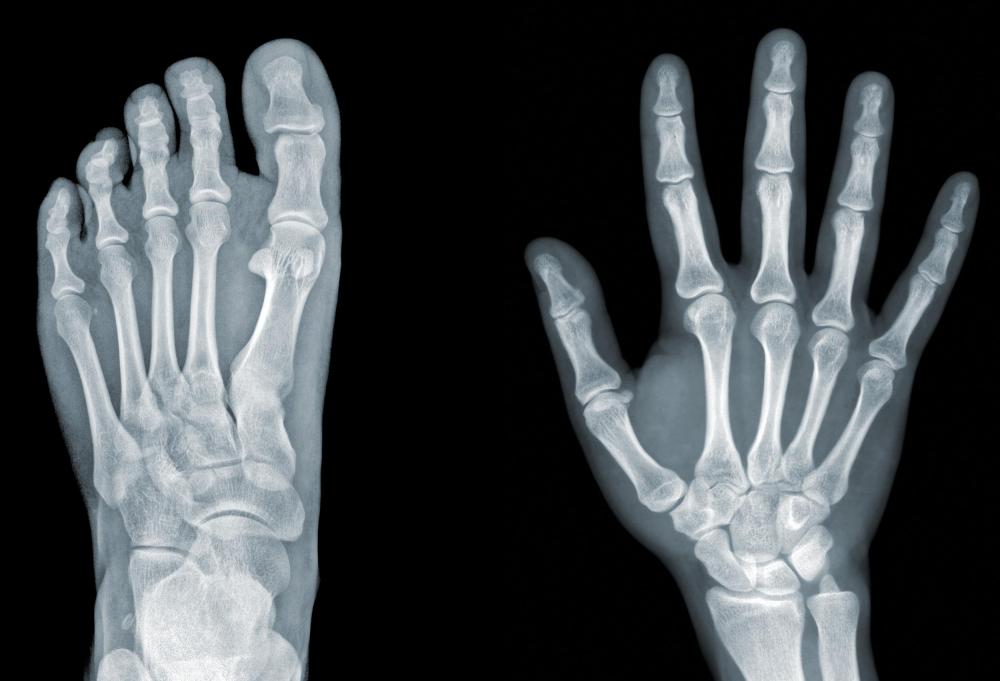At WiseGEEK, we're committed to delivering accurate, trustworthy information. Our expert-authored content is rigorously fact-checked and sourced from credible authorities. Discover how we uphold the highest standards in providing you with reliable knowledge.
How do X-Rays Work?
Most people are familiar with the concept of X-rays. In fact, many people have experienced having X-rays taken, either at the request of a doctor or a dentist. Not everyone understands the process that allows X-rays to work, however. Here is some background on X-rays, and how they are used in a number of situations.
The discovery of a method to produce X-rays is usually attributed to Wilhelm Conrad Röntgen, a physicist at the University of Wurzburg during the latter 19th century. On 8 November 1895, Röntgen first developed the process that came to be known as Röngten rays and later X-rays. The original designation of Röntgen ray tended to be used by the scientific community, and in most of Röntgen's surviving notes and speeches, he usually refers to the phenomenon as X-rays. Röntgen's work provided him with the distinction of being the first recipient of the Nobel Prize for Physics in 1901.

X-rays are able to penetrate through non-metallic materials. This property makes it possible to use X-ray equipment to create an image of the human body that allows a physician to get a look at what is happening inside without the need for an invasive procedure. The process involves creating a concentrated beam of electrons and smashing them into some sort of metal film. The result of that crash between the metallic film and the highly charged electrons is a concentration of high-energy electromagnetic radiation. This radiation is what is normally termed X-rays.

Along with the sheet of metallic film, a second sheet serves as a filter that prevents the beam from scattering or making the image produced by the action foggy or otherwise difficult to view. As the image appears, the portions of the body that contain certain elements, such as calcium-enriched bones, will appear outlined. Other mineral deposits help to identify the presence of growths such as tumors, and other irregularities can be seen, such as breaks in the bones or foreign objects in the body, like knife blades or bullets. In some instances, the patient may ingest what is known as a contrast agent, such as barium or iodine. This helps to make the presence of blood vessels and organs appear more prominently on the X-ray.

X-ray technology is not without some degree of risks. High levels of exposure to radiation in a short period of time can produce a variety of health problems. Still, the occasional exposure to X-rays during an annual checkup or at the dentist's office are not likely to result in any type of permanent damage. X-rays are not recommended for pregnant women in most cases, however.

X-rays are not just used for imaging the human body for medical purposes. The same basic process is used to scan baggage at many airports, check suspicious packages at a post office or courier depot, and to scan the interior of walls to check for electrical lines and pipes before demolition of the wall.
AS FEATURED ON:
AS FEATURED ON:















Discussion Comments
One of the worst parts of going to the dentist, for me at least, is getting the dental x rays. They worry me, partly because of all the things I have heard about how x rays can be harmful. While I know that I only get them once or twice a year, and maybe once a year in other forms, x rays still kind of frighten me.
I suppose this helps explain why doctors and x ray technicians always leave the room while the x ray machine is working; even moderate exposure to those machines on a daily basis would be very detrimental to one's health.
Post your comments